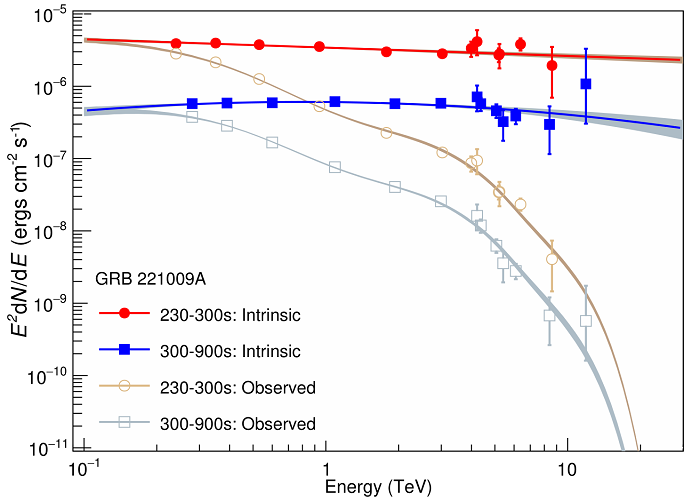LHAASO Gamma-ray Finding Opens Door to New Physics
The Large High Altitude Air Shower Observatory (LHAASO) has officially released the precise energy spectrum for the highest-energy gamma-ray radiation from Gamma-Ray Burst (GRB) 221009A, the brightest GRB observed to date. This finding challenges the standard radiation model of GRB afterglows, revealing that the intensity of cosmic background light in the infrared band is lower than expected. Additionally, this measurement provides crucial information for examining Einstein’s special relativity theory and new physics, such as exploring axions as candidate particles for dark matter. The results were published by the LHAASO collaboration, which is led by the Institute of High Energy Physics of the Chinese Academy of Sciences, on Nov. 15 in Science Advances.
A GRB is a sudden increase in gamma-ray emission from a specific direction in the sky, caused by the most violent type of astronomical explosion since the Big Bang. The first GRB was discovered in 1967. Since 2019, three GRBs with high energy emissions have been detected and photons up to 1 TeV (1 TeV = 1 trillion electron volts) have been recorded. On Oct. 9, 2022, LHAASO recorded photons from GRB 221009A with energies exceeding 10 TeV, regarded as a milestone in the six-decade history of GRB research. GRB 221009A is the brightest GRB ever observed and was found initiated by the collapse of a massive star—more than 20 times heavier than the Sun—when its nuclear fuel ran out. Prior to this report, LHAASO had published precise measurements of the complete temporal variation of this GRB’s radiation in the TeV band, confirming its afterglow radiation and revealing why this GRB is so bright. The earlier study was published in Science in June 2023.
In the standard GRB model, afterglow radiation originates from the collision of explosion relics, traveling at nearly the speed of light, with the surrounding gas. This causes high-speed shock waves that accelerate electrons to very high energies. These electrons then further scatter the surrounding photons to become high-energy gamma-rays. Theoretically, the intensity of this radiation decreases rapidly as photon energy increases. However, LHAASO did not observe such a rapid drop of photon flux even at energies up to 13 TeV, as shown in the figure below. This poses a challenge to the GRB standard model and hints that photons around 10 TeV might be produced by more complex particle acceleration processes or new radiation mechanisms.
High-energy gamma-ray photons are generally absorbed by diffuse background light throughout the universe on their very long journey to Earth. Stronger absorption occurs for photons at higher energies. Therefore, it should be very rare to detect gamma-rays from a distant GRB at 10 TeV, even though LHAASO has been able to detect photons at 1 PeV (1 PeV = 1000 TeV) from much closer celestial bodies within the Milky Way. Therefore, measuring the absorption of gamma-rays can put constraints on the intensity and properties of cosmic background light, which is the sum of radiation from all galaxies in the whole universe. Thus, this is an issue closely related to cosmic evolution.
The extreme brightness of GRB 221009A provides an opportunity to detect high-energy gamma-ray photons from a source 2.4 billion light-years away. According to the conventional model of cosmic evolution, the probability of a 1-TeV gamma-ray photon surviving absorption by background light is 20% after traveling 2.4 billion light-years, while the survival probability of a 10-TeV gamma-ray photon drops to 0.5%. According to the energy spectrum measured by LHAASO, the background light intensity is found much lower than expected. In other words, background light intensity in the infrared band is only about 40% of that estimated using existing cosmological models. This prompts a reevaluation of the formation and evolution of galaxies in the universe.
If the standard model of cosmic evolution is assumed, however, the unexpectedly low absorption of high-energy gamma-ray photons might indicate the existence of new physics mechanisms beyond the standard model of particle physics. For example, if there was even a tiny break in the Lorentz symmetry, which is the foundation of Einstein’s special relativity, this effect could be amplified into observable phenomena for photons after a long flight of 2.4 billion light-years. These phenomena could thus cause the high-energy gamma-ray spectrum observed by LHAASO. Alternatively, the existence of axions could also explain the unexpectedly weak absorption of the high-energy gamma-rays. Axions are particles beyond the standard model, one of the widely discussed candidate particles for dark matter. In summary, LHAASO’s observation has opened the door to a new physics. Much more related research is foreseen in the near future.
LHAASO is a major national scientific and technological infrastructure facility located on Haizi Mountain at an altitude of 4410 meters in Daocheng County, Sichuan Province. It consists of a one-square-kilometer ground-based array of 5216 electromagnetic particle detectors and 1188 muon detectors, a 78,000-square-meter water Cherenkov detector array, and 18 wide-angle Cherenkov telescopes. Completed in July 2021, LHAASO has begun high-quality and stable operation. It is the most sensitive ultra-high-energy gamma-ray detection device in the world, with a large field of view and all-weather monitoring capability, covering two-thirds of the sky every day. This discovery fully demonstrates LHAASO’s internationally unparalleled sensitivity and unique research advantages.

Fig. 1: Gamma-ray energy spectrum of GRB221009A in the rising phase (230–300 seconds) and the decaying phase (300–900 seconds). Hollow points represent the gamma-ray flux measured by LHAASO on Earth, while solid points represent the derived gamma-ray flux emitted by the GRB at a distance of 2.4 billion light-years.
Citation:
The LHAASO Collaboration, Very high-energy gamma-ray emission beyond 10 TeV from GRB 221009A. Sci. Adv.9, eadj2778(2023). DOI:10.1126/sciadv.adj2778
Contact:
Institute of High Energy Physics, CAS
Songzhan Chen
Email: chensz@ihep.ac.cn
Tel: +86-10-88235124
Yichun Liu
Email: ycliu@ihep.ac.cn
Tel: +86-10-88235014
Contact Information
Ms. JIA Yinghua
jiayh@ihep.ac.cn
